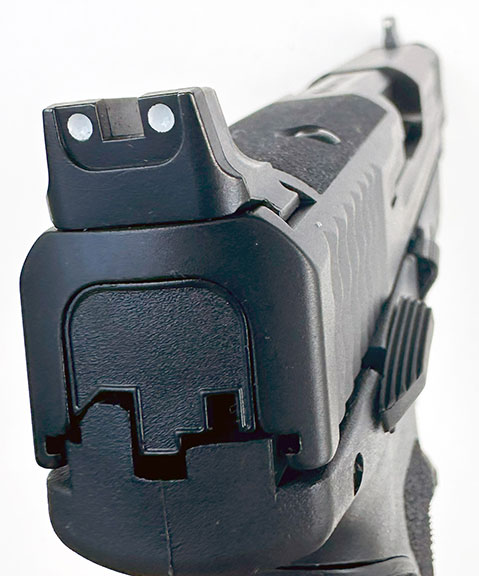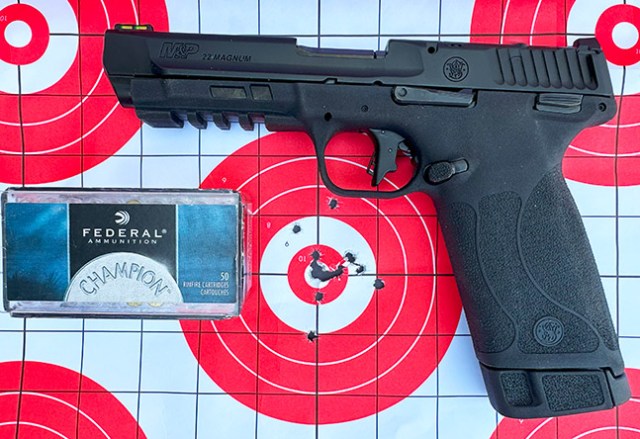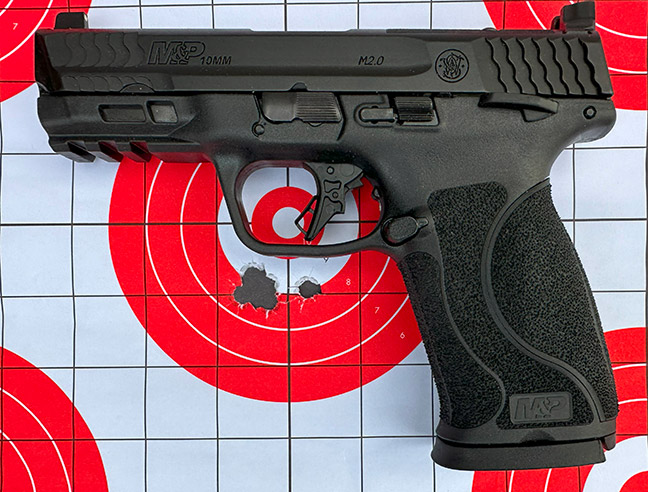Smith & Wesson first attached the Military & Police Moniker to the Model 10 revolver back in 1899. The Model 10 is still being produced today, but it’s just one of many models that S&W calls M&P with the lineup now including AR-style rifles and a rather extensive line of semi-automatic pistols. The popular 9mm, 40 S&W, and .45 ACP sidearms were first introduced to compete with Glock for the law enforcement market but soon became a favorite among the concealed carry crowd.
I remember my first introduction to the M&P 9mm (2009) while attending various NRA courses to become a Texas Concealed Carry instructor. Fans of the gun touted its moderate recoil and ease of handling. Based on the recommendation of some of my fellow instructor candidates, I bought a 9mm M&P.

As time went on, and I became a writer in addition to being an instructor and running a gun store, I found it easy to justify getting first one, then another, until I had examples of nearly all the M&P pistols in Smith & Wesson’s lineup. I even bought several used models that were police trade-ins to stash in various places around the house.
The .22 compact and full-size versions made great training tools. The Performance Center C.O.R.E. model was a great way to learn about and start using red dot sights. I used a .45 model with my first suppressor. Viking Tactical’s VTAC model made a great carry gun. Before I knew it, I had a pretty good collection of M&Ps.
Two models recently added to the product line have really piqued my interest. It just so happens, they slide in perfectly to fill a couple of obvious gaps in the lineup. On the top end is the 10mm and near the bottom is the .22 Magnum. I don’t live in bear country, so why do I need a 10mm? Because they don’t make an 11.
M&P 10mm Auto
I quit shooting .40s when the FBI did, because the recoil bothered me as it did them. So, why wouldn’t the 10mm bother me? Well, I’m not going to be shooting it all day, but it’s just different. I don’t know why, but when I shoot a .40 caliber gun it tries to twist my hand. By contrast, the 10mm guns recoil straight back. By comparison, most 10mm cartridges are stronger than a .45 ACP, but they’re not quite up there with a .44 Magnum. So, for me, if I need or want a little more punch, it’s nice to have a 10mm, but it’s not something I’m going to shoot a lot of in one session.
Previously, I wrote an article about how I thought this might be the year of the 10mm. Taurus introduced the TH10 and now S&W has its 10mm. I suspect Ruger and others will soon follow. A few years back, I sold my .45 ACP Springfield XDm and replaced it with a 10mm version of the same gun. I really like how that 10mm shoots. Let me show you a chart, then we’ll discuss it. This is for Federal HST ammunition. You can see here, for this brand, the .45 ACP is a much slower cartridge. That’s pretty much true of all brands.
| Caliber | Weight (Grains) | Velocity (feet per second) | Muzzle Energy (foot/lbs.) |
| 9mm | 147 | 1,000 | 326 |
| .40 S&W | 180 | 1,010 | 410 |
| 10mm | 200 | 1,130 | 567 |
| .45ACP | 230 | 890 | 405 |
According to the chart, and looking primarily at the muzzle energy figure, the 10mm ought to be knocking the shooter on their butt. I don’t know if it’s because it’s a longer cartridge than the .40 S&W or what, but to me, subjectively, it doesn’t hurt to shoot as much as the .40 S&W does.
The M&P brings some things to the table my other 10mm pistols don’t have. Its slide is cut for an optic, and the gun is delivered with mounting plates for several common red dot sight footprints. It is available with either a 4- or 4.5-inch barrel. Mine has a 4-inch barrel. It weighs 27.8 ounces, is 7 inches long, 5.6 inches high, and 1.3 inches wide.
The fixed three-dot sights are elevated to coexist with a typical red dot. The sights are also tritium night sights. It has the newer M2.0 flat-face trigger which breaks at 4 pounds, 3 ounces. Its low barrel bore axis helps reduce muzzle rise and facilitates faster aim recovery. Like all M&Ps, it features an 18-degree grip angle for natural point of aim.

The gun ships with four interchangeable palm swell grip inserts for optimal hand fit and trigger reach. The 2.0 grip texture allows the user to manage recoil and keep a firm grip in all sorts of weather conditions. The 1 in 10-inch twist M&P M2.0 barrel enhances accuracy.
An extended, rigid, embedded stainless-steel chassis is there to reduce flex and torque when firing. Another improvement, the takedown lever and sear deactivation systems allow for disassembly without pulling the trigger. The slide has fish scale serrations front and rear. It is also ambidextrous.
M&P .22 Magnum
The new S&W M&P22 Magnum is a polymer-framed autoloader that pairs a TEMPO gas-operated barrel system with an internal hammer-fired action — the same one used in the M&P 5.7. The M&P22 Magnum is optics-ready, fully ambidextrous, has a flat-faced trigger, and 4.35-inch stainless-steel barrel. It ships with two 30-round, flush-fitting magazines. If you’ve never owned a .22 Magnum, they are some fun to shoot. It has a loud report and spits fire (so much fire they almost blind you at night).

The caliber is sometimes called .22 Winchester Magnum Rimfire, but also .22 WMR, .22 Magnum, .22 WMRF, .22 MRF, or .22 Mag. These are all different names for the same cartridge. The U.S. military M4 rifle makes the same size hole as a .22 Magnum. Both rounds measure .224 inches at the base, but there is a significant difference in performance.
An AR shooting a 5.56 drives a 55-grain bullet at 3,200 fps, while a .22 WMR handgun drives a 40-grain bullet at something around 2,200 fps. The terminal concept of both rounds is to destroy flesh or internal organs by a tumbling action. So, although we don’t seriously recommend a .22 Magnum as a self-defense gun, in a pinch, it could become one — especially with a 30-round magazine.
Part of its potential as a defensive weapon is the loudness of the bang and the brightness of the muzzle flash. Nobody wants to get shot, and the .22 WMR does a great job of imitating a more powerful gun. It’s lightweight, has a 3-pound trigger, and is the same size as the S&W 5.7×28, but a lot cheaper to shoot. Makes a darn good varmint pistol, too. MSRP on the 10mm’s runs $669 to $749. MSRP for the 22 Magnum is $649 (at the time of this writing).
How many M&Ps do you own? What are your favorite calibers? How would the 10mm or .22 Mag fit in your collection. Share your answers or M&P review in the Comment section.
Read the full article here



















